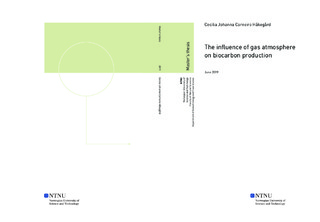| dc.contributor.advisor | Bruheim, Per | |
| dc.contributor.advisor | Carlsson, Per (ekstern) | |
| dc.contributor.author | Håkegård, Cecilia Johanna Carneiro | |
| dc.date.accessioned | 2019-10-26T14:00:20Z | |
| dc.date.available | 2019-10-26T14:00:20Z | |
| dc.date.issued | 2019 | |
| dc.identifier.uri | http://hdl.handle.net/11250/2624585 | |
| dc.description.abstract | Fokuset på en mer bærekraftig metallindutri har økt de siste årene. Et alternativ for å redusere CO2 utslippene er å erstatte fossilt kull som reduksjonmiddel med trekull. Elkem er verdensledende innenfor produksjon av silisium og ferrosilisium. I 2017 var 21% av reduksjonsmiddelet i Elkems prosess basert på fornybare råvarer. Mengden trekull som brukes i deres prosess i dag er ca. 35000 tonn/år, som vil øke til 188000 tonn/år i 2030. Trekull produseres ved termisk dekomponering av biomasse uten tilgang til oksygen. Denne prosessen heter pyrolyse. Overgangen fra fossilt kull til trekull byr på spesielt to utfordringer for Elkem. Fossilt kull er billigere enn trekull, og de vil trenge en stor andel av tremassen tilgjengelig for norsk industri for å produsere alt trekullet de trenger. En løsning til begge utfordringene er å øke utbyttet av trekull fra pyrolyseprosessen. Målet i denne masteroppgaven var å undersøke om endring av gassatmosfæren i pyrolysereaktoren kan øke utbyttet av trekull eller endre dens egenskaper. Syv forskjellige eksperimenter ble utført, hvor tre forskjellige gasser ble testet; N2 (inert), CO2 og CO. Resultatene fra CO eksperimentene ble sammenlignet med simuleringsresultater. Utbyttet av trekull, kondensat og gass ble beregnet etter hvert eksperiment. Proximate analyse, termogravimetrisk (TGA) analyse, Brunauer–Emmett–Teller (BET) overflateareals analyse, tetthetsanalyse og Scanning electron miktroskopi (SEM) analyse ble brukt for å analysere trekullet fra eksperimentene.
Utbyttet av trekull og kondensat ble ikke påvirket av å endre gassatmosfæren. De ble funnet til å være 29.8±0.3 wt.% og 46.0±0.4 wt.%, respektivt, for alle eksperimentene med hold-temperatur 480°C. For eksperimentene med hold-temperatur 580°C ble trekullutbyttet 27.1 wt.%, uavhengig av gassatmosfære. Proximate analysen viste at trekullet som var produsert i CO2 eller CO atmosfære hadde signifikant høyere fikst karbon (FC) innhold. Fikst karbon utbyttet ble funnet til å være 0.227g FC/g biomasse for trekullet som ble produsert i ren N2 atmosfære ved 480°C, mens 0.243 og 0.240g FC/g biomasse for trekullet som ble produsert i CO2 og CO atmosfære ved samme temperatur, respektivt. TGA resultatene viste at massetapet var større mellom 400°C og 600°C for trekullet produsert i inert atmosfære enn trekullet produsert i CO2 og CO. SEM bildene viste at trekullet som ble produsert i eksperimenter hvor N2 var brukt under holdfasen hadde spindelvevlignende strukturer i noen av porene. Resultatene i denne masteroppgaven er lovende, men noe motsigende. De viser at det er mulig å forbedre trekullkvaliteten ved å ha CO2 eller CO atmosfære, uten å påvirke trekullutbyttet negativt. | |
| dc.description.abstract | Increasing focus on sustainable metal production has brought up the possibility of replacing fossil coal as a reducing agent with biocarbon to reduce CO2 emissions. Elkem is one of the world’s leading suppliers of silicon alloys. In 2017, 21% of the reducing agent in Elkem’s process was from renewable resources. The amount of biocarbon used in their process today corresponds to approximately 35000 tons/year, which will be increased to 188000 tons/year in 2030. Biocarbon is produced by thermal decomposition of biomass in the absence of oxygen, which is a process called pyrolysis. Two challenges Elkem face are that biocarbon is more expensive than fossil coal, and their process will require a significant amount of Norwegian wood dedicated to industry to meet their future goals. A promising solution to both these challenges is to increase the biocarbon yield from pyrolysis. The objective of this master thesis was to investigate the possibility of changing the gas atmosphere to increase the biocarbon yield and/or its properties. Seven different experiments were conducted, where three different carrier gases were tested; N2 (reference), CO2 and CO. Results from the CO experiments were compared with simulated results. The biocarbon, condensate and gas yields were determined after the experiments. Proximate analysis, thermogravimetric analysis (TGA), Brunauer–Emmett–Teller (BET) surface area, density analysis and scanning electron microscopy (SEM) were used to analyze the produced biocarbon.
The biocarbon and condensate yields were not affected by altering the carrier gas. They were found to be 29.8±0.3 wt.% and 46.0±0.5 wt.%, respectively, for experiments with hold temperature 480°C. When the pyrolysis temperature was increased to 580°C the biocarbon yield decreased to 27.1 wt.%. Proximate analysis revealed that the fixed carbon (FC) content was higher for biocarbon produced in CO2 and CO atmosphere. The fixed carbon yield was found to be 0.227 g FC/g biomass for biocarbon produced in N2 atmosphere at 480°C, while it was found to be 0.243 and 0.240 g FC/g biomass for biocarbon produced in CO2 and CO atmosphere, respectively. TGA results showed that biocarbon from the reference experiment had higher mass loss between 400°C and 600°C than biocarbon from experiments with CO2 and CO as carrier gas. SEM images revealed that when N2 was used as carrier gas during the hold phase, the biocarbon had spiderweb-like structures in some of the pores. This was not observed in the biocarbon samples produced in pure CO2 or CO atmosphere. The results obtained in this master thesis are contradictory, yet promising, and indicate that the biocarbon quality can be increased by changing the pyrolysis gas atmosphere, without decreasing the biocarbon yield. | |
| dc.language | eng | |
| dc.publisher | NTNU | |
| dc.title | Påvirkning av gassatmosfære på trekullproduksjon | |
| dc.type | Master thesis | |
